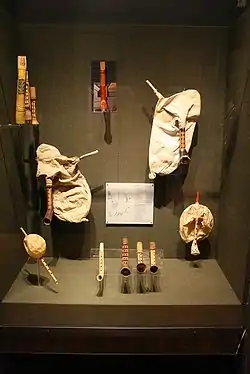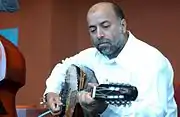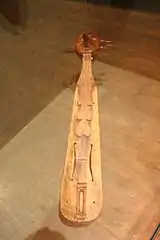Greek folk music
Greek folk music (Greek: παραδοσιακή μουσική, "traditional music"; also δημοτικά τραγούδια, "folk songs") includes a variety of Greek styles played by ethnic Greeks in Greece, Cyprus, Australia, the United States and elsewhere. Apart from the common music found all-around Greece, there are distinct types of folk music, sometimes related to the history or simply the taste of the specific places.
| Music of Greece | |
|---|---|
 | |
| General topics | |
| Genres | |
| Specific forms | |
| Media and performance | |
| Music awards | |
| Music charts | |
| Music festivals | |
| Music media | |
| Nationalistic and patriotic songs | |
| National anthem | "Hymn to Liberty" |
| Regional music | |
| Related areas | Cyprus, Pontus, Constantinople, South Italy |
| Regional styles | |
Overview

The Greek folk music, in Greek Demotiko or Paradosiako, refers to the traditional Greek popular songs and music of mainland Greece and islands dated to the Byzantine times. It was the sole popular musical genre of the Greek people until the spread of rebetiko and laiko in the early 20th century, spread by the Greek refugees from Asia Minor. This kind of music evolved from the ancient and the medieval Greek era and was established until the present day.[1][2]
The lyrics are based on Demotiki (folk) poetry (usually by anonymous lyricist) and popular themes are love, marriage, humor, death, nature, water, sea, religious, about klephts, armatoloi, various war fighters or battles etc
The songs are played mainly in the following tempos: Syrtos (various versions), Kalamatianos, Tsamiko, Ballos, Sousta and Pentozali (Crete).
Some notable folk songs include "Itia", "Milo mou kokkino", "Kontoula lemonia", "Mou parigile to aidoni", "Enas aetos", "Kira Vangelio", "Gerakina", "Saranta palikaria" and from nisiotika "Ikariotikos", "Samiotisa", "Thalassaki", "Armenaki", "Amorgos Sousta", "Dirlada", "Lygaria", "Psaropoula", such as "Tilirkiotissa" and "Psintri Vasilitsia mou" (Cyprus).
Crete


The Greek islands of Kárpathos, Khálki, Kássos and Crete form an arc where the Cretan lyra is the dominant instrument. Kostas Mountakis is probably the most widely respected master of the lyra, which is often accompanied by the laouto which resembles a mandolin. Askomandoura (a type of bagpipe) is also used. Crete has also a well known folk dance tradition, which includes swift dances like pentozalis and other like sousta, syrtos, trizali, katsabadianos, chaniotikos, siganos, pidichtos Lasithou, maleviziotikos, tsiniaris, ierapetrikos and laziotikos.
Aegean islands

The Aegean islands of Greece are known for Nisiótika (means from islands) songs; Greek characteristics vary widely. Although the basis of the sound is characteristically secular-Byzantine, the relative isolation of the islands allowed the separate development of island-specific Greek music. Most of the nisiótika songs are accompanied by lyra, guitar, tsampouna, souravli and violin.
Notable singers include Yiannis Parios and the Konitopoulos family; Mariza Koch is credited with reviving the field in the 1970s. Folk dances include the ballos, syrtos, sousta, chiotikos, kalymniotikos, stavrotos, lerikos, kamara, michanikos, trata, panagia and ikariotikos.
In the Aegean Cyclades, the violin is more popular than Cretan lyra, and has produced several respected musicians, including Nikos Oikonomidis, Leonidas Klados and Stathis Koukoularis. Folk dances in Cyclades include lerikos, syrtos, syrtos Serifou, syrtos Naxou, syrtos Kythnou, Amorgos dance and ballos. One of the most famous singers of Cycladic music is Domna Samiou.
In Dodacanese there are prominent elements of Cretan music. Dodecanese folk dances include the trata, ballos, syrtos, kremasti, issos, syrtos Rodou, michanikos and kalymnikos, with origin from the island of Kalymnos.
Central Greece
In central Greece many folk songs make references to the klephts and their role during the Greek war of independence. Folk dances in central Greece include: antikrystos, hasapiko, kalamatianos, kamilierikos choros, koulouriotikos, syrtos, tsamiko, choros tis tratas, chatzichristos and syrtokalamatianos. The musical tradition of the region is also influenced by the Arvanites.
Epirus
In Epirus, folk songs are pentatonic and polyphonic, sung by both male and female singers. Distinctive songs include mirolóyia (mournful tunes), vocals with skáros accompaniment and tis távlas (drinking songs). The clarinet is the most prominent folk instrument in Epirus, used to accompany dances, mostly slow and heavy, like the tsamikos, koftos, menousis, fisouni, podia, sta dio, sta tria, zagorisios, kentimeni, metsovitikos and iatros.
Peloponnese
Folk dances from the Peloponnese include the kalamatianos, kariatidon, monodiplos, tsakonikos, syrtos, Ai Georgis, maniatikos and diplos horos. In the songs there are also references to the klephts. In Mani there is also the tradition of the "μοιρολόγια" mirolóyia (laments), sung by the old women of Mani.
Ionian Islands

The Ionian Islands were never under Ottoman control and their songs and kantadhes (καντάδες) are based a lot on the western European style. Greek kantadhes are performed by three male singers accompanied by mandolin or guitar. These romantic songs developed mainly in Kefalonia in the early 19th century but spread throughout Greece after the liberation of Greece.
An Athenian form of kantadhes arose later, accompanied by violin, clarinet and laouto. However the style is accepted as uniquely Heptanesean. The island of Zakynthos has a diverse musical history with influences also from Crete. Folk dances include the tsirigotikos (Cythera), leukaditikos, ballos, syrtos, Ai Georgis, Kerkyraikos (Corfu).
Notable songs are "Kato sto yialo", "S'ena paporo mesa", "Apopse tin kithara mou".
The Church music (Byzantine) of the islands is also different from the rest of Greece, with a lot of western and Catholic influences on the Orthodox rite. The region is also notable for the birth of the first School of modern Greek classical music (Heptanesean or Ionian School, Επτανησιακή Σχολή), established in 1815.
Macedonia
Folk dances in Macedonia include Makedonia (dance), hasapiko, leventikos, zonaradiko, endeka Kozanis, samarinas, stankena, akritikos, baidouska, Macedonikos antikristos, mikri Eleni, partalos, kleftikos Makedonikos, bougatsas, kastorianos, tromakton, o Nikolos, antikrystos, sirtos Macedonias and Kapitan Louka. There are also folk songs which make references to the Macedonian Struggle (Greek Struggle for Macedonia), while it is notable the use of tympana, trumpets and koudounia ("chálkina" in local idioma). Other instruments used include violin, clarinet and Macedonian lyra.
Thessaly
Folk songs from Thessaly are slow and stately, and include dances like the kalamatianos (popular allover Greece), thessalikos, koftos, tsamikos, kleistos, kangeli, gaitanaki, pilioritikos, svarniara, sta tria, karagouna and galanogalani.
Dionysiakos, take place especially every year, before Easter, in Tyrnavos, where occurs the famous Phallus Festival; a pagan fertility festival in honour of the ancient God Dionysus, with food and drink.
Thrace
Instruments used in ancient Thracian music such as bagpipes (gaida) and Byzantine lyra are still the ordinary instruments of folk music in Thrace. Folk dances include the tapeinos horos, tripati, tromakton, sfarlis, souflioutouda, zonaradiko, kastrinos, syngathistos, sousta, mantilatos, baintouska, tsestos, and apadiasteite sto choro. Traditional Thracian dances are usually swift in tempo and are mostly circle dances in which the men dance at the front of the line. The gaida, a kind of bagpipe, is the most characteristic instrument, but clarinets are also used. The Thracian gaida, also called avlos, is different from the Macedonian or other Bulgarian bagpipes. It is more high in pitch than the Macedonian gaida but less so than the Bulgarian gaida (or Dura). The Thracian gaida is also still widely used throughout Thrace in northeastern Greece. Chronis Aidonidis is the most popular singer of the genre.
Pontus
Pontic music retains elements of the musical traditions of ancient Greece, Byzantine music and the tradition of Caucasus.
The prime instruments in Pontic music are the Pontic lyra, which has origins in Byzantine times and it is related closely with the Byzantine lyra and Cretan lyra. They are used also other bowed musical instrument from the West, like the Kit violin and Rebec. Other instruments include drums, lute, askomandoura (a type of bagpipe), davul and aulos. Folk dances from Pontus include omal, atsiapat, dipat, tik, tik diplon, tromakton, Pontiaki serra, ikosiena, and trygona.
Constantinople
The most known Greek dance and rhythm of Constantinopolitan Greeks is hasapikos. It is originated in the Middle Ages as a battle mime with swords, adopted by the Byzantine military. In Greek it was called μακελλάριος χορός (makellarios horos). The use of politiki lyra and politiko laouto is also common. Hasapiko served later as one of the bases for the sirtaki and it is danced all over Greece, today also with the use of bouzouki.
Cyprus

Cyprus is an independent country, currently contested between the Republic of Cyprus and the internationally unrecognized Turkish Republic of Northern Cyprus. Cyprus includes a variety of classical, folk and popular genres. Cypriot folk music is similar to the folk music of Greece and includes dances like sirtaki, syrtos, tatsia, antikristos and mainly the use of laouto.
See also
- Greek dances
- Dora Stratou
- Swallow song of Rhodes; Greek folk song composed by Athenaeus
References
- "Greek Traditional Music": Ινστιτούτο έρευνας μουσικής και ακουστικής - Institute for research on music and acoustics.
- Samuel Baud-Bovy, Δοκίμιο για το Ελληνικό Δημοτικό Τραγούδι, 3rd edition, Πελοποννησιακό Λαογραφικό Ίδρυμα, Ναύπλιο: 1966, pp. 1–13. (Υπάρχει μια συνεχής εξέλιξη από την αρχαία Ελληνική μουσική έως και το δημοτικό τραγούδι, η οποία μαρτυρείται, εκτός από τη γλώσσα, στο ρυθμό, τη δομή και τη μελωδία).
%252C_Bestanddeelnr_928-5025.jpg.webp)
